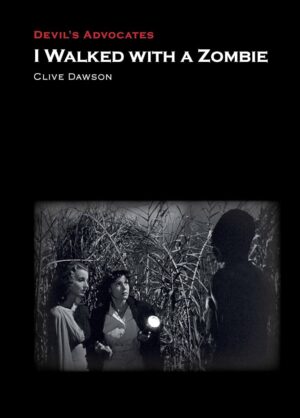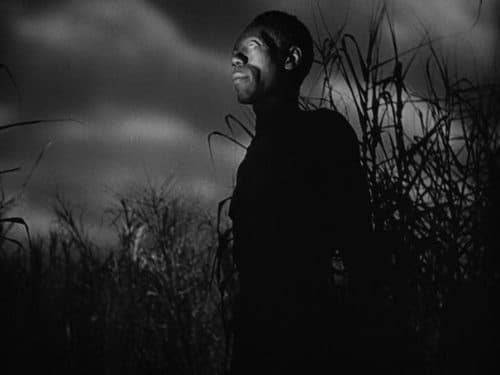
Ah, it’s been a while since I reviewed a Devil’s Advocates title. For anyone not currently in the know about this series of books: they’re each focused on an influential horror film, each book has a different author, and offers different kinds of focus and perspectives, but without fail you can expect a detailed, academic-lite study of the selected film title (and there are over fifty books in the series, to date). Clive Dawson’s book is on the seminal Val Lewton work, I Walked with a Zombie (1943). It’s a timely study: so often, IWWAZ tends to crop up in zombie film books which are en route to writing about the Romero ‘ghoul’ type of zombie, and can feel a little like a pit-stop – which is clearly unfair to such an innovative piece of cinema. Dawson redresses that here, in a five-chapter book (adding up to a little over a hundred pages). There’s an introduction, a full bibliography and, helpfully, a reference list at the end of each chapter, too. He begins the introduction by spending time cementing IWWAZ as a very important title, looking at it alongside Lewton’s other most important early work The Cat People; as these two titles appeared within months of each other, they suggested that Lewton’s groundbreaking style wasn’t simply a fluke, and they each helped to bolster his early reputation as a careful and conscientious producer.
Dawson also provides early evidence of how IWWAZ pushed narrative boundaries, at a time when narrative cinema was still in its relative infancy. However, Dawson refers to Lewton’s “modest revolution”, one not always best served by lurid publicity campaigns, even accepting that RKO were already struggling by the 1940s, grasping at straws, or else simply wrongheadedly doing what they saw as best in trying to promote their roster. Lewton’s was a modest revolution, then, because his style and approach was so often markedly different to those taken by his professional peers. However, revolutionary it certainly still was. Drawing on literary influences like Jane Eyre and Rebecca, challenging accepted attitudes to representations of race and colonialism; Dawson puts across a strong case for Lewton as a revolutionary filmmaker, and you could perhaps suggest that Dawson’s own enthusiastic but measured tone seems to echo Lewton’s own.
Chapter 1 offers some background on Lewton’s early life and how his production unit came to be. These two things are linked together: Val Lewton’s early experiences as a writer, then as a story editor and finally as a new ‘horror guy’ whose role would be to generate new styles of horror – horror to rival Universal’s own highly successful version of same – each overlap with one another. Yet it was all a big gamble for Lewton, who privately agonised about the financial insecurity of his career. Still, he took on the task – officially as a producer, albeit a very involved one, keen to push the artistic freedoms being granted, while they were still being granted. Think Covid was hard on filmmaking? Try World War II, where everything from fuel allowances to the critical presentation of anything deemed antithetical to American interests could change, or even be pulled at any point, jeopardising entire projects. And then there was the burning question: how will audiences respond to this kind of nuanced, literary horror? Dawson successfully provides a sense of the great affordances and limitations surrounding the birth of the film.
In terms of context, there’s some interesting information about the short story Lewton based the film upon, and the treatment of its author, Inez Wallace (often mistakenly identified as a male author) – albeit that her own story didn’t come out of a blue sky, and owed some debt to pre-existing authors (William Seabrook, for one). The reading public had already been tantalised with certain ideas of ‘zombies’ by the time of the film’s inception, something with which Lewton had to tread quite carefully to secure his own screenplay, and the development of the film’s script is discussed here – something which turned out to be quite a complex process. At this point, Dawson gives some consideration to the relationship between Lewton and director of IWWAZ, Jacques Tourneur, considering the notion of auteurship – but briefly, and it doesn’t shift the focus of the book. At this point (Chapter 3) there’s a detailed walk-through of the film itself, including mention of a deleted ending, and then a section on the film’s critical reception, early promotion and release (both at home in the US and, where the recorded information allows, overseas). This part of the book has a bittersweet element, noting how Lewton’s successes quickly built his reputation, but that reputation placed ever greater demands upon him and his health. He died at the tragically young age of forty-six, having suffered his first heart attack at just forty-one. But the book ends on a more positive note with an informative assessment of the film’s influence on other works, in its own decade and far beyond it.
Dawson’s book is a pleasure to read. It boasts wonderfully clear prose which unpicks a great deal of information and presents it back to us is a nicely flowing, easy to follow format. This also ensures a calm, considered and well-evidenced approach to the film, including dispelling myths and misconceptions about it wherever necessary. It’s obvious that there’s a wealth of research and knowledge at play here, though never crowding the text with dry stats or else losing focus. The book doesn’t opt for any particularly left-field or academic kinds of critique – there’s no long deviations into Deleuze, for example – but sticks closely with the film itself, discussing context as and when it springs from the film itself, rather than seeking to apply it. There are no axes to grind here. It’s a good approach, it’s a consistent approach, and all in all, this is an enjoyable, fresh and timely study of a film which clearly still rewards audiences eighty years after its inception.
To buy a copy of I Walked with a Zombie, please head direct to LUP in the UK, and to Amazon in the US.
